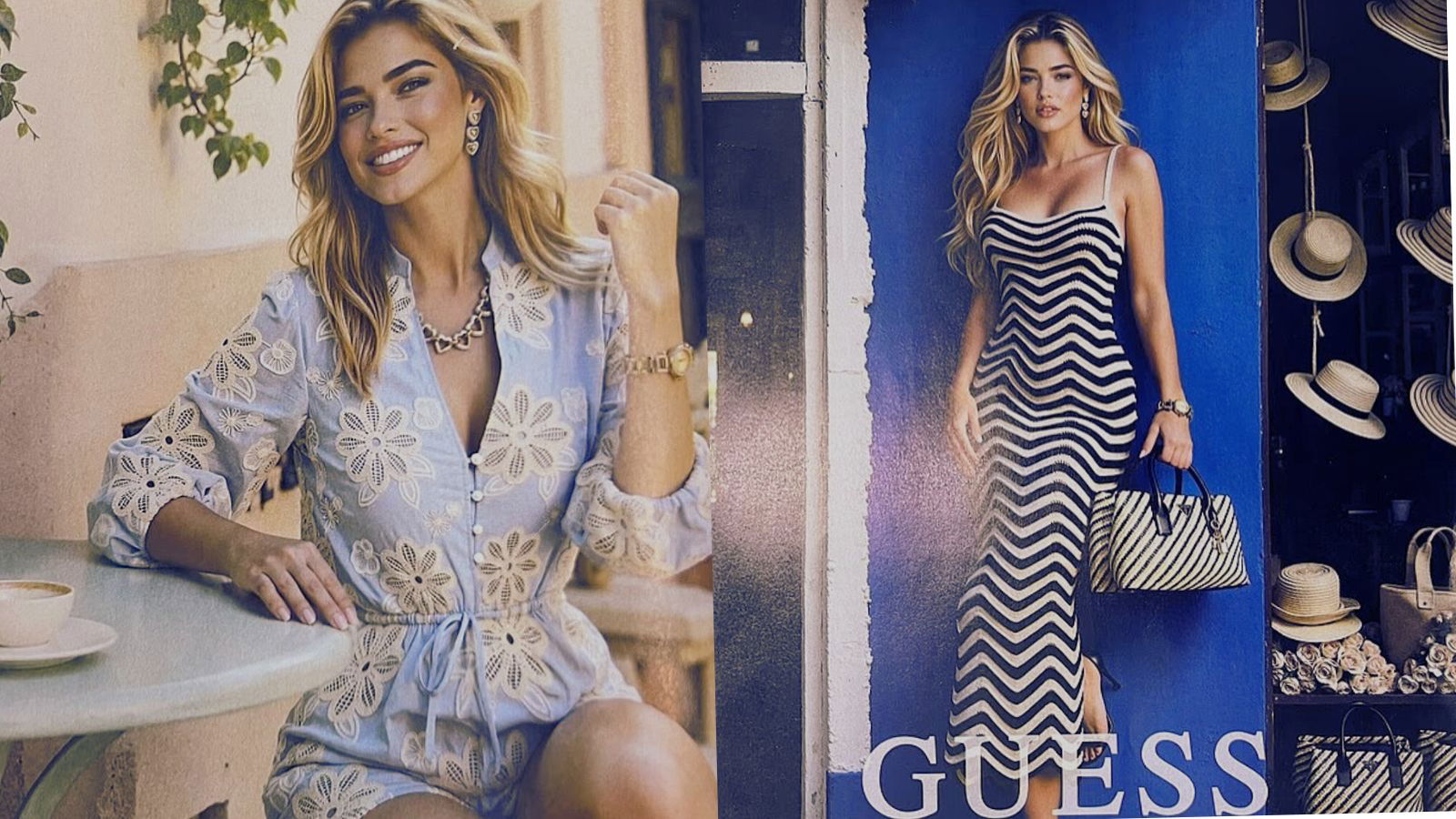
Outrage erupts as Vogue runs Guess ad with AI-generated model
share on
Fashion’s uneasy flirtation with artificial intelligence has once again taken centre stage - this time in the pages of Vogue. A new Guess advertisement featuring an AI-generated model has ignited criticism across social media, as the debate over creativity, labour and beauty standards in fashion intensifies.
The August issue of Vogue includes a two-page spread showing a blonde model in two outfits: a pale blue romper adorned with cream floral appliqué, and a black-and-white chevron dress, complete with a matching handbag. The styling is editorial, the model poised and striking. But a small line of text in the corner reads: “Produced by Seraphinne Vallora on AI.”
The model does not exist.
The campaign was created by Seraphinne Vallora, an AI-driven creative studio co-founded by designers Valentina Gonzalez and Andreea Petrescu. According to the duo, their aim is to democratise high-fashion visuals through design-led AI tools.
Don't miss: Can an 'AI generated' label really build trust, or will it slow the industry down?
Social media backlash
The ad’s quiet disclosure went viral after TikTok user @lala4an posted a video highlighting the Vogue spread. The video quickly amassed over 2 million views, with many users voicing disappointment and criticising both Guess and Vogue for sidelining real models.
“Beauty standards are already insane right now. It’s gonna reach levels of impossible for young women because poor girls are gonna start comparing themselves to not even humans,” one user commented.
YouTuber Isabel Brown said in a reaction video: “No actual human being has body proportions naturally like this with that symmetrical of a face and that airbrushed of skin. There already was major societal backlash to magazines trying to make women look completely unattainable and not realistic whatsoever.”
Neither Vogue nor Guess has issued a public statement as of this writing. Guess has also not posted the ad on its social media channels, but that hasn’t stopped commenters from leaving criticism across unrelated posts.
Vallora defends the work
The only response so far has come from Seraphinne Vallora itself. On Instagram, the studio addressed the criticism directly.
“Why can’t engineers, graphic designers, 3D artists, coders, architects - any kind of creative - build beauty too?” the company wrote. “We understand people may think AI will be replacing jobs, but in reality, it’s just like any other tool in the design industry and it creates jobs, because these images are AI-driven but made by humans, creatives and designers.”
In an interview with BuzzFeed, co-founder Petrescu recalled how the project began as a way to promote their own jewellery brand without the budget for models. The effort snowballed into viral success.
“We started going viral, because nobody was doing this at the time,” she said. “Paul [Marciano, co-founder of Guess] is a very fearless man. He’s a trendsetter. So he decided, ‘I like this, I want it.’”
Petrescu and Gonzalez insist their creations aren’t mere prompts fed into a public tool. They describe a detailed process involving mood boards, stylists, and occasionally, real photographers and models for pose testing. The final result, they argue, is just as curated - and labour-intensive - as a traditional campaign.
The line between fantasy and reality is growing harder to trace. Petrescu acknowledges that some viewers might not realise the Guess model isn’t real. “If they don’t realise it’s digitally made, I don’t feel like there’s blame to be placed on us,” she said. “We do disclose it, the brands we work with do disclose it.”
The studio’s Instagram feed - which boasts over 220,000 followers - is filled with AI-generated women with flawless skin, plump lips and chiseled features. The pair admit these fantasy-driven images outperform more diverse representations.
“It’s not even us, it’s the public,” Gonzalez said. “If they loved the diversity, we would have flooded our Instagram with diversity.”
While critics argue this trend exacerbates fashion’s long-running struggle with inclusivity and unattainable standards, Gonzalez pushes back. “We are not creating a new standard. The standard has always been there.”
Guess is not alone in exploring digital alternatives. Earlier this year, H&M made headlines for its plans to create digital clones of real models, though the brand noted it would do so “in a responsible way.” Meanwhile, Seraphinne Vallora is offering AI “twins” for real-life models, allowing talent to “take two jobs at the same time” by appearing in different locations simultaneously.
Join us on 20 August at PR Asia 2025 and take charge of the new era of PR. Tackle trust head-on, stay ahead of shifting policies, and harness AI to power up your comms game. Get inspired, get connected, and get future-ready.
Related articles:
Why quality data is the missing ingredient in AI-powered personalisation
AI won’t replace creativity - it’ll supercharge It
Luxury goes pop: How music videos are the new catwalks for high fashion brands
share on
Free newsletter
Get the daily lowdown on Asia's top marketing stories.
We break down the big and messy topics of the day so you're updated on the most important developments in Asia's marketing development – for free.
subscribe now open in new window
